The Dynamical Analysis of a Prey-Predator Model with a Refuge-Stage Structure Prey Population
Abstract
We proposed and analyzed a mathematical model dealing with two species of prey-predator system. It is assumed that the prey is a stage structure population consisting of two compartments known as immature prey and mature prey. It has a refuge capability as a defensive property against the predation. The existence, uniqueness, and boundedness of the solution of the proposed model are discussed. All the feasible equilibrium points are determined. The local and global stability analysis of them are investigated. The occurrence of local bifurcation (such as saddle node, transcritical, and pitchfork) near each of the equilibrium points is studied. Finally, numerical simulations are given to support the analytic results.
1. Introduction
The development of the qualitative analysis of ordinary differential equations is deriving to study many problems in mathematical biology. The modeling for the population dynamics of a prey-predator system is one of the important and interesting goals in mathematical biology, which has received wide attention by several authors [1–6]. In the natural world many kinds of prey and predator species have a life history that is composed of at least two stages: immature and mature, and each stage has different behavioral properties. So, some works of stage structure prey-predator models have been provided in a good number of papers in the literatures [7–12]. Zhang et al. in [9] and Cui and Takeuchi in [11] proposed two mathematical models of prey stage structure; in these models the predator species consumes exclusively the immature prey. Indeed, there are many factors that impact the dynamics of prey-predator interactions such as disease, harvesting, prey refuge, delay, and many other factors. Several prey species have gone to extinction, and this extinction must be caused by external effects such as overutilization, overpredation, and environmental factors (pollution, famine). Prey may avoid becoming attacked by predators either by protecting themselves or by living in a refuge where it will be out of sight of predators. Some theoretical and empirical studies have shown and tested the effects of prey refuges and making an opinion that the refuges used by prey have a stabilizing influence on prey-predator interactions; also prey extinction can be prevented by the addition of refuges; for instance, we can refer to [13–23]. Therefore, it is important and worthwhile to study the effects of a refuge on the prey population with prey stage structure. Consequently, in this paper, we proposed and analyzed the prey-predator model involving a stage structure in prey population together with a preys refuge property as a defensive property against the predation.
2. Mathematical Model
- (1)
The immature prey grows exponentially depending completely on its parents with growth rate r > 0. There is an intraspecific competition between their individuals with intraspecific competition rate δ1 > 0. The immature prey individual becomes mature with grownup rate β > 0 and faces natural death with a rate d1 > 0.
- (2)
There is an intraspecific competition between the individuals of mature prey population with intraspecific competition rate δ2 > 0. Further the mature prey species faces natural death rate too with a rate d2 > 0.
- (3)
The environment provides partial protection of prey species against the predation with a refuge rate 0 < m < 1; therefore there is 1 − m of prey species available for predation.
- (4)
There is an intraspecific competition between the individuals of predator population with intraspecific competition rate δ3 > 0. Further the predator species faces natural death rate too with a rate d3 > 0.
Theorem 1. All the solutions of system (3) that initiate in the positive octant are uniformly bounded.
Proof. Let W = y1 + y2 + y3 be solutions of system (3) with initial conditions, y1(0) > 0, y2(0) > 0, and y3(0) > 0. Then by differentiation W with respect to t we get
3. Local Stability Analysis
- (1)
The trivial equilibrium points E0 = (0,0, 0) exist always.
- (2)
The predator free equilibrium point is denoted by , where
() -
while is a positive root of the following third-order polynomial
() -
here, , , , and A4 = (a3 − a1b1)/b1 exist uniquely in the interior of y1y2-plane if and only if the following condition holds:
() - (3)
The interior (positive) equilibrium point is given by , where
() -
while is a positive root of the following third-order polynomial:
() -
here,
() -
Clearly, (11) has a unique positive root represented by if the following set of conditions hold:
() -
Therefore, E2 exists uniquely in int. if in addition to condition (13) the following conditions are satisfied.
()
4. Global Stability
In this section the global stability for the equilibrium points of system (3) is investigated by using the Lyapunov method as shown in the following theorems.
Theorem 2. Assume that the vanishing equilibrium point E0 is locally asymptotically stable; then it is globally asymptotically stable in if and only if the following condition holds:
Proof. Consider the following positive definite real valued function:
Theorem 3. Assume that the predator free equilibrium point is locally asymptotically stable; then it is globally asymptotically stable in if the following condition holds:
Proof. Consider the following positive definite real valued function:
Theorem 4. Assume that the interior equilibrium point is locally asymptotically stable in ; then it is globally asymptotically stable if and only if the following condition holds:
Proof. Consider the following positive definite real valued function around E2:
5. Local Bifurcation
Theorem 5. System (3) undergoes a transcritical bifurcation near the vanishing equilibrium point, but saddle node bifurcation cannot occur, when the parameter a3 passes through the bifurcation value .
Proof. According to the Jacobian matrix J(E0) given by (16), system (3) at the equilibrium point E0 with has zero eigenvalue, say , and the Jacobian matrix becomes
Theorem 6. Assume that condition (22) holds; then system (3) undergoes a transcritical bifurcation near the predator free equilibrium point E1, but saddle node bifurcation cannot occur, when the parameter b4 passes through the bifurcation value .
Proof. According to the Jacobian matrix J(E1) given by (19), system (3) at the equilibrium point E1 with has zero eigenvalue, say , and the Jacobian matrix becomes
Theorem 7. Assume that condition (21) holds; then system (3) undergoes a saddle node bifurcation near the predator free equilibrium point E1 when the parameter a1 passes through the bifurcation value .
Proof. According to the Jacobian matrix J(E1) given by (19), system (3) at the equilibrium point E1 with has zero eigenvalue, say , and the Jacobian matrix becomes
Theorem 8. Assume that
Proof. According to the determinant of the Jacobian matrix J(E2) given by D3 in (25), condition (62) represents a necessary condition to have nonpositive determinant for J(E2). Now rewrite the form of the determinant as follows:
Let be the eigenvector corresponding to the eigenvalue . Thus gives , where and are positive due to the Jacobian elements and represents any nonzero real number. Also, let represent the eigenvector corresponding to eigenvalue of . Hence gives that , where and are negative due to the Jacobian elements and denotes any nonzero real numbers. Now, since
6. Numerical Simulations
Clearly, Figure 1 shows the asymptotic approach of the solutions, which started from different initial points to a positive equilibrium point (0.46, 0.15, 0.42), for the data given by (69). This confirms our obtained result regarding the existence of globally asymptotically stable positive point of system (3) provided that certain conditions hold.
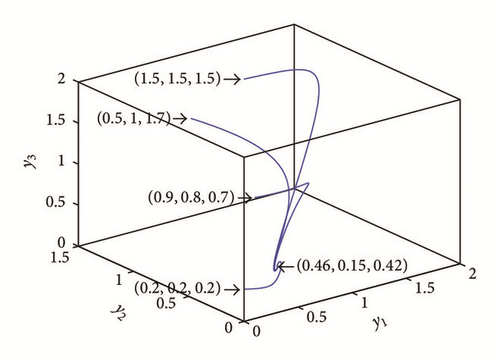
Now in order to discuss the effect of the parameters values of system (3) on the dynamical behavior of the system, the system is solved numerically for the data given in (69) with varying one parameter each time. It is observed that varying parameters values a2, a4, b2, b3, and b4 have no qualitative effect on the dynamical behavior of system (3) and the system still approaches to a positive equilibrium point. On the other hand, when a1 decreases in the range (a1 ≤ 1.05) keeping other parameters fixed as given in (69) the dynamical behavior of system (3) approaches asymptotically to the vanished equilibrium point as shown in the typical figure given by Figure 2. Similar observations have been obtained on the behavior of system (3) in case of increasing the parameter a3 in the range (a3 ≥ 0.8) or decreasing the parameter b1 in the range (b1 ≤ 0.2), with keeping other parameters fixed as given in (69), and then the solution of system (3) is depicted in Figures 3 and 4, respectively. Finally, for the parameters a2 = 0.9 and b4 = 0.7 with other parameters fixed as given in (69), the solution of system (3) approaches asymptotically to the predator free equilibrium point as shown in the Figure 5.
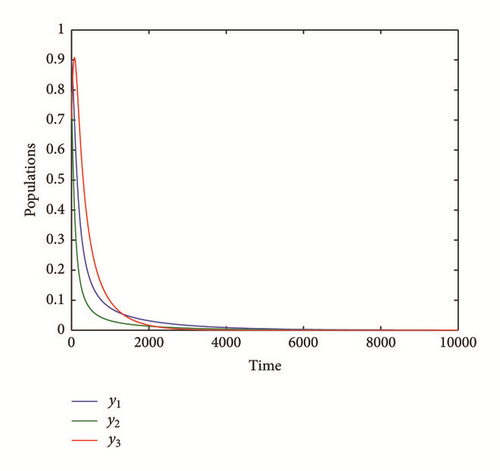
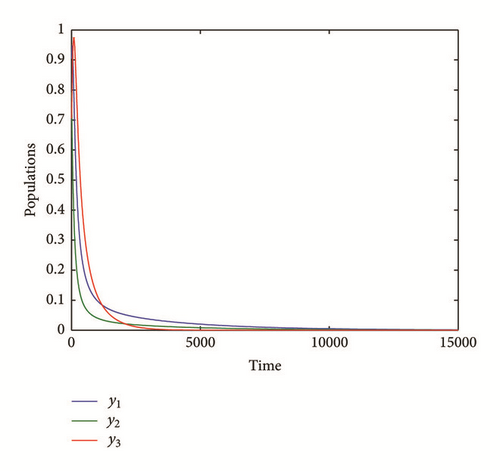
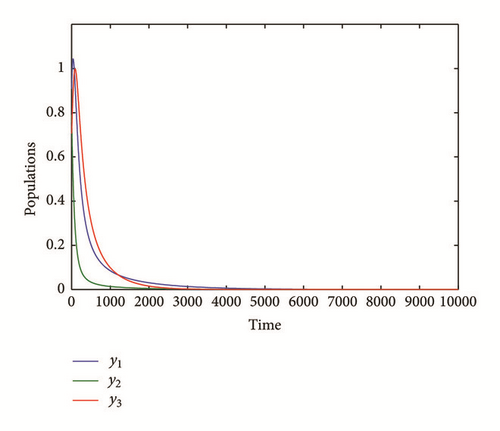
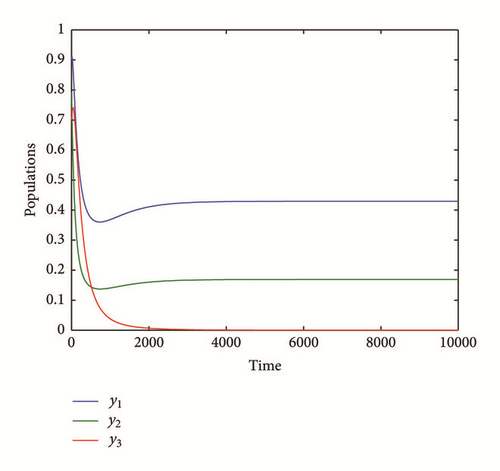
7. Discussion
- (1)
System (3) has no periodic dynamics rather than the fact that the system approaches asymptotically to one of their equilibrium points depending on the set of parameter data and the stability conditions that are satisfied.
- (2)
Although the position of the positive equilibrium point in the interior of changed as varying in the parameters values a2, a4, b2, b3, and b4, there is no qualitative change in the dynamical behavior of system (3) and the system still approaches to a positive equilibrium point. Accordingly adding the refuge factor which is included implicitly in these parameters plays a vital role in the stabilizing of the system at the positive equilibrium point.
- (3)
Decreasing in the value of growth rate of immature prey or in the value of conversion rate from immature prey to mature prey keeping the rest of parameter as in (69) leads to destabilizing of the positive equilibrium point and the system approaches asymptotically to the vanishing equilibrium point, which means losing the persistence of system (3).
- (4)
Increasing in the value of grownup rate of immature prey keeping the rest of parameter as in (69) leads to destabilizing of the positive equilibrium point and the system approaches asymptotically to the vanishing equilibrium point too, which means losing the persistence of system (3).
- (5)
Finally, for the data given by (69), increasing intraspecific competition of immature prey and natural death rate of the predator leads to destabilizing of the positive equilibrium point and the solution approaches instead asymptotically to the predator free equilibrium point, which confirm our obtained analytical results represented by conditions (21)-(22).
Competing Interests
The authors declare that they have no competing interests.




